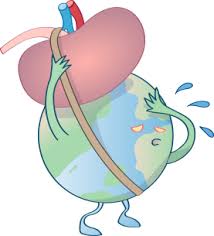By Erica Ho, Research Associate
Did you know that approximately 13% of the world’s population has chronic kidney disease (CKD), and over 10% have end-stage kidney failure1? In the 1990’s, CKD was the 17th most common cause of death in the world, but has risen to 12th by 20172. This may be because previous efforts to reduce CKD and CKD-related mortality either have not been successful, or do not exist. This is an even more concerning issue because low- and middle-income countries face disproportionately higher rates of CKD and CKD-related mortality than higher-income countries do. Currently, approximately 80% of all patients being treated for CKD live in high-income status countries, such as the United States, United Kingdom, and France, even though overall, the CKD cases in these high-income countries only account for 12% of the total number of cases in the world3. Meanwhile, the remaining 20% of patients being treated are from low-income countries, which make up more than 50 of the world’s total population3. One study estimates that the incidence rate of CKD in low- and middle-income countries is four times higher than in developed, higher-income countries4. The lack of resources in these countries, including easily-accessible hospitals, dialysis centers, and data-collecting technologies to track CKD rates, makes it especially hard for CKD patients to get the life-saving treatment they need and for these countries to reduce their CKD-related mortality rates.
Additionally, various barriers may make it difficult for people in low- and middle-income countries to access renal replacement therapies (RTT), such as dialysis and transplant, even if they are in adequate supply. Several studies have found that the financing of RTT is largely unaffordable for many people in developing countries and is one of the most prominent barriers to tackling the global burden of CKD3,5. This is extremely concerning, since the provision of more dialysis centers or hiring more transplant surgeons would not fix this issue. Instead, policy changes to achieve financial neutrality or the development of financial support programs would help mitigate this barrier. Through these solutions, more people would worry less about financial burdens and be able to seek the RTT they need. In addition to financial barriers, social and cultural barriers should also be discussed. Several studies have been conducted to show that low health literacy6 and cultural perceptions of illness and organ donation7,8 have contributed to underutilization of RTT. These barriers can potentially be addressed through culturally-sensitive and linguistically-appropriate CKD and RTT education. Through improvements in education, early-stage CKD patients and people risk for CKD can prevent the disease from progressing, and those in later stages can have the knowledge they need to make informed choices about their treatment path. Lastly, there are systemic and infrastructural barriers that need to be addressed. In one study on preventing CKD in sub-Saharan African countries, it was found that the lack of CKD knowledge within large decision-making agencies, including governmental and non-governmental organizations, contributes to the inability of these countries to decrease CKD rates9. These agencies need trained epidemiologists, nephrology experts, patient advocates, and stakeholders, these agencies do not have the knowledge, passion, or funding required to make the appropriate fiscal health decisions to fix this issue.
Future efforts towards reducing the global burden of CKD depends largely on developing financial support services, culturally- and linguistically-appropriate education, and policy change to raise awareness about CKD among all levels of organization. Here at TREC, we do work that can be influential to kidney disease research efforts around the world. One example is our constant dedication towards patient-centered and health literate education development. TREC has collaborated and partnered with various external organizations, including UCLA Health and Health Literacy Media, to provide kidney patients with digital and print education to help guide their kidney transplant journey. TREC has also created the Living Donation Storytelling Project. This is another tool that aims to give kidney patients a personalized educational experience through kidney donors, recipients, and advocates talking about their living donation experiences. Though TREC works mainly with other organizations in the United States and Canada, its core mission of kidney transplant education, research, and advocacy can be applied to the international stage. CKD is a preventable disease; with adequate support and continuous advancements in research, the global burden of CKD can e greatly reduced, which will lead to higher quality of life and longer life expectancies for people living in low- and middle-income countries and a massive step forward towards achieving global health equity.
- Hill NR, Fatoba ST, Oke JL, et al. Global Prevalence of Chronic Kidney Disease – A Systematic Review and Meta-Analysis. PloS one. 2016;11(7):e0158765-e0158765.
- Bikbov B, Purcell CA, Levey AS, et al. Global, regional, and national burden of chronic kidney disease, 1990–2017: a systematic analysis for the Global Burden of Disease Study 2017. The Lancet. 2020;395(10225):709-733.
- Couser WG, Remuzzi G, Mendis S, Tonelli M. The contribution of chronic kidney disease to the global burden of major noncommunicable diseases. Kidney International. 2011;80(12):1258-1270.
- George C, Mogueo A, Okpechi I, Echouffo-Tcheugui JB, Kengne AP. Chronic kidney disease in low-income to middle-income countries: the case for increased screening. BMJ Global Health. 2017;2(2):e000256.
- Mushi L, Marschall P, Fleßa S. The cost of dialysis in low and middle-income countries: a systematic review. BMC Health Services Research. 2015;15(1):506.
- Boateng EA, East L, Evans C. Decision-making experiences of patients with end-stage kidney disease (ESKD) regarding treatment in Ghana: a qualitative study. BMC Nephrology. 2018;19(1):371.
- Bennett PN, Hany A. Barriers to kidney transplants in Indonesia: a literature review. International Nursing Review. 2009;56(1):41-49.
- Muralidharan A, White S. The Need for Kidney Transplantation in Low- and Middle-Income Countries in 2012: An Epidemiological Perspective. Transplantation. 2015;99(3).
- Arogundade FA, Barsoum RS. CKD Prevention in Sub-Saharan Africa: A Call for Governmental, Nongovernmental, and Community Support. American Journal of Kidney Diseases. 2008;51(3):515-523.

